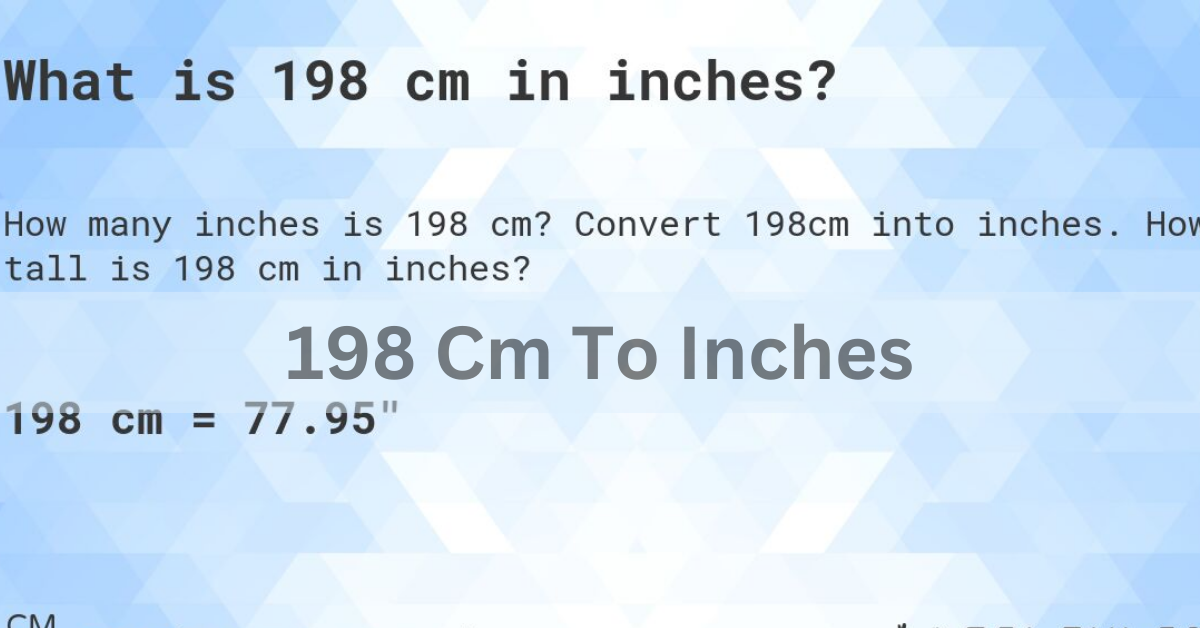198 Cm To Inches – Exploring Measurement Conversion In 2024!
In the world of measurement, the ability to convert between different units is a fundamental skill with widespread applications across various domains, including science, engineering, construction, and everyday life. One common conversion that individuals often encounter is the conversion of centimeters (cm) to inches. In this comprehensive exploration, we’ll delve into the process of converting 198 centimeters to inches, providing detailed explanations, practical examples, and insights along the way.
Understanding the Units:

Before diving into the conversion process, it’s essential to have a clear understanding of the units involved:
- Centimeters (cm): Centimeters are a unit of length in the metric system, widely used worldwide for measuring smaller distances. They are particularly convenient for everyday measurements, such as the height of a person or the length of an object.
- Inches: Inches belong to the imperial system of measurement, predominantly used in the United States and a few other countries. While the metric system is more prevalent globally, inches still find significant use, especially in industries like construction, woodworking, and manufacturing.
Conversion Formula and Relationship:
To convert centimeters to inches, we utilize a conversion factor that relates the two units:
1 inch=2.54 centimeters
1 inch=2.54 centimeters
This conversion factor implies that one inch is equivalent to 2.54 centimeters. Therefore, to convert centimeters to inches, we divide the number of centimeters by 2.54.
Conversion Process:
Let’s apply the conversion factor to convert 198 centimeters to inches:
198 cm÷2.54=77.9527559 inches
198 cm÷2.54=77.9527559 inches
While this result provides the precise conversion, it’s often more practical to round it to a reasonable number of decimal places. In this case, we’ll round the result to two decimal places:
198 cm≈77.95 inches
198 cm≈77.95 inches
Also Read: MediaTakeOut 2015 – A Comprehensive Review In 2024!
Using the Conversion:
Once we have the converted value of 77.95 inches, we can apply it in various contexts:
Height Measurement: When discussing the height of a person, expressing it in inches can make it more relatable, especially for individuals accustomed to the imperial system.
Product Dimensions: In industries like manufacturing or woodworking, where inches are commonly used, expressing dimensions in inches provides clarity and consistency in communication.
Practical Applications:

Interior Design: When planning room layouts or furniture placement, knowing dimensions in inches helps ensure precise measurements and optimal use of space.
Construction: In construction projects, measurements are often specified in inches for accuracy and compatibility with standard building materials and tools.
FAQ’s
1. What are centimeters and inches?
Centimeters (cm) are a metric unit of length used worldwide for smaller measurements, while inches belong to the imperial system, primarily used in the United States and a few other countries.
2. Why is it important to understand centimeters and inches?
Understanding these units is crucial for accurate measurement and communication, as they are commonly used in various fields like science, engineering, and construction.
3. What is the conversion factor between centimeters and inches?
The conversion factor is 1 inch = 2.54 centimeters, indicating that one inch is equivalent to 2.54 centimeters.
4. How is the conversion process from centimeters to inches done?
To convert centimeters to inches, you divide the number of centimeters by 2.54, as indicated by the conversion factor.
5. What is the result of converting 198 centimeters to inches?
The precise conversion yields 77.9527559 inches, but for practical purposes, it’s often rounded to two decimal places, resulting in approximately 77.95 inches.
6. In what contexts can the converted value of 77.95 inches be used?
The converted value can be applied in various scenarios, such as discussing a person’s height or specifying product dimensions, especially in industries where inches are commonly used.
7. How does expressing measurements in inches benefit interior design?
Knowing dimensions in inches aids in planning room layouts and furniture placement, ensuring precise measurements and optimal utilization of space.
8. Why are measurements often specified in inches in construction projects?
In construction, measurements are frequently specified in inches for accuracy and compatibility with standard building materials and tools.
9. What are some practical applications of understanding measurement conversions?
Practical applications include academic studies, professional endeavors, and everyday tasks where accurate measurement and communication are essential.
10. What does mastering measurement conversions empower individuals to do?
Mastering measurement conversions empowers individuals to communicate effectively, make informed decisions, and navigate diverse measurement systems with confidence and precision.
11. How does understanding the relationship between centimeters and inches facilitate communication?
Understanding this relationship enables seamless communication across different measurement systems, promoting clarity and accuracy in various fields and industries.
12. Why is it valuable to have a fundamental understanding of measurement units?
A fundamental understanding of measurement units is valuable as it fosters efficiency, accuracy, and effective communication in both professional and everyday contexts.
Conclusion
Converting measurements between different units, such as centimeters and inches, is a valuable skill with numerous practical applications. By understanding the conversion formula and relationship between the units, individuals can navigate diverse measurement systems confidently and accurately. Whether for academic, professional, or everyday purposes, mastering measurement conversions empowers individuals to communicate effectively and make informed decisions across various fields and industries.
.




